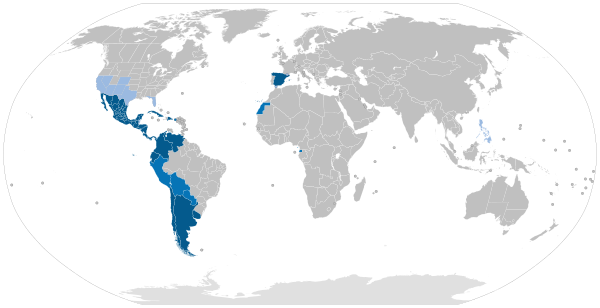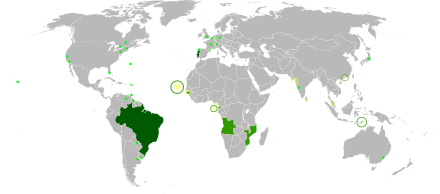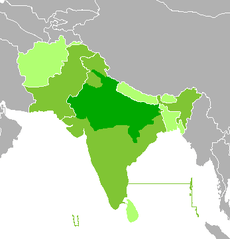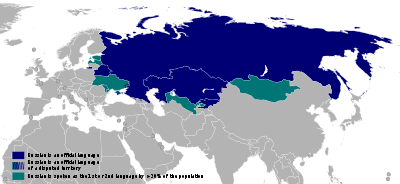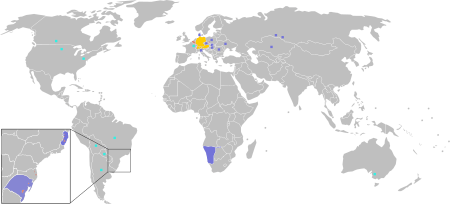World language
A world language is one that is spoken internationally and learned and spoken by numerous people as a second language. A world language is characterized not only by the total number of speakers (native and second language speakers) but also by geographical distribution and its use in international organizations and diplomatic relations.[1][2]
The most widely spoken (and likely the fastest spreading) world language today is English, with over 1.1 billion native and second-language users worldwide.[3] On similar grounds, French is also commonly categorized as a world language. Other possible world languages include Spanish, Arabic, Hindustani language (Hindi-Urdu), Mandarin Chinese, Russian and Portuguese.
Historically, Aramaic, Ancient Greek, Latin, Classical Chinese, Persian, Sanskrit, and Classical Arabic have also functioned as world languages due to their previous standings as lingua francas over large parts of the world.
Overview
Asian languages
Arabic
Arabic gained international prominence because of the medieval Islamic conquests and the subsequent Arabization of the Middle East and North Africa, and it is also a liturgical language amongst Muslim communities outside the Arab World.
Chinese
Standard Chinese is the direct replacement of Classical Chinese, which was a historical lingua franca in East Asia, also referred to academically as the East Asian cultural sphere in terms of culture, until the early 20th century, and today serves as a common language between speakers of other varieties of Chinese not only within China proper (between the Han Chinese and other unrelated ethnic groups), but in overseas Chinese communities. It is also widely taught as a second language internationally.
Indian languages
The major languages of the Indian subcontinent have numbers of speakers comparable to those of major world languages primarily due to the large population in the region rather than a supra-regional use of these languages, although Hindustani (including all Hindi dialects, and Urdu), Bengali and Tamil may fulfill the criteria in terms of supra-regional usage and international recognition. Tamil is spoken widely in Southern India. Tamil is an official language in Sri Lanka and Singapore. Tamil is recognized as a minority language in the constitution of South Africa [4]. Tamil is used in the currency of Mauritius [5]. Tamil is one of the three recognized languages of education in Malaysia.[6] The Canadian government recognized the month of January as the Tamil heritage of month.[7] As an example, the native speaking population of Bengali vastly outnumber those who speak French as a first language, and it is one of the most spoken languages (ranking fifth[8] or sixth[9]) in the world with nearly 230 million total speakers, and is known for its long and rich literary tradition.
European languages
English
In addition to 370 million native speakers, English is estimated to have over 610 million second-language speakers,[3] including anywhere between 200 and 350 million learners/users in China alone,[10] at varying levels of study and proficiency, though this number is difficult to accurately assess.[11] English is also increasingly becoming the dominant language of scientific research and papers worldwide, having even outpaced national languages in Western European countries, including France, where a recent study showed that English has massively displaced French as the language of scientific research in "hard" as well as in applied sciences.[12] English is the most common of the languages used on the Internet. As of 2019, according to one survey, English is used by 54.0% of the world's top 10 million websites,[13] and according to another survey, 25.5% of all Internet users are English speakers.[14]
French
During the 19th and early 20th centuries, French was the language of communication and diplomacy, and the favoured second language among the elite and the educated classes in Europe (including Russia, Romania, Bulgaria, and Greece) — as well as in many Middle East and North African countries such as Syria, Egypt, Ottoman Turkey and Iran. In addition, French enjoyed high status in its colony in Indochina, and in several South American ones like Argentina, Brazil, Chile, and Uruguay. However, French has declined steadily since World War I, being gradually displaced by English - although in Lebanon, Tunisia, Algeria and Morocco, French continues to be the favoured second language, as well as enjoying co-official status in Canada, Switzerland and Belgium. Moreover, French still remains one of the working languages of many international organizations, including the United Nations, NATO, European Union and NAFTA. French is the principal working language of the European Court of Justice. French is also internationally recognized to be of high linguistic prestige, still used in diplomacy and international commerce, as well as having a significant portion of second language speakers throughout the world.[15]
German
German, although it had many different dialects which formed a language continuum from Holland and Flanders in the northwest, through Schleswig in the north across to East Prussia in the northeast, down to Styria and Lower Austria in the southeast and Bern and South Tyrol in the south, served as a lingua franca in large portions of Europe for centuries, mainly within the Holy Roman Empire and the eastern areas of the Kingdom of Prussia (which later included additional areas of previously Polish territory), and later within the Austro-Hungarian Empire and other areas where Germans settled, such as the Baltic States and Transylvania. It remains an important second language in much of Central and Eastern Europe, and in the international scientific community. It is the most widely spoken native language in the European Union as well as one of the three "procedural languages" of its institutions alongside English and French.[16] As of 2019, it is the third most commonly used language for website content, with 5.8% of the world's top 10 million websites using it,[13] and 2.1% of all Internet users are German speakers.[14]
Russian
Russian is the largest native language in Europe, the most geographically widespread language in Eurasia,[17] one of the six official languages of the United Nations, and one of two official languages aboard the International Space Station. As of 2019, it is the second most commonly used language for website content, with 5.9% of the world's top 10 million websites using it,[13] and 2.5% of all Internet users are Russian speakers.[14]
Russian was used in the Russian Empire and the Soviet Union, and its teaching was made compulsory in the Eastern Bloc countries. However, the use and teaching of Russian has declined sharply in both the former Eastern bloc and the near abroad since the break up of the Soviet Union and Russia's deputy education minister was quoted as saying in December 2013 that the number of Russian speakers had fallen by 100 million since that date.[18][19][20] It is still widely spoken throughout the Caucasus, Central Asia, Eastern Europe and the Baltic states.
Spanish
Spanish is the world's second-most spoken native language, after Mandarin Chinese. Spanish was used in the Spanish Empire and today is in use in Spain, in Latin American countries (except Brazil, French Guiana and Haiti), and is widely spoken in many parts of the United States, particularly in Florida and the states which border Mexico. By 2011, around 13% of the US population fluently speaks Spanish.[21] Indeed, by 2016 Spanish was the most widely taught non-English language in American secondary schools and schools of higher education.[22] It is also an official language of the United Nations. As of 2019, Spanish had the third-largest number of internet users by language with 7.9%, after English with 25.2% and Chinese with 19.3%.[14]
History
Historical languages which had international significance as the lingua franca of a historical empire include Egyptian in Ancient Egypt; Sumerian, Akkadian, and Aramaic in the various Mesopotamian civilizations and empires in the Ancient Near East; Ancient Greek in the Greek colonies in the form of various dialects, evolving to Koine Greek in the Hellenistic world, after the conquests of Alexander the Great and the Macedonian Empire, and subsequently in the eastern part of the Roman Empire and the territories of the Byzantine Empire; Latin in the Roman Empire and presently as the standard liturgical language for the Catholic faithful worldwide; Classical Chinese in East Asia during the Imperial era of Chinese history; Persian during the various succeeding Persian Empires, and once served as the second lingua franca of the Islamic World after Arabic;[23] Sanskrit during the ancient and medieval historical periods of various states in South Asia, Southeast Asia, and Central Asia, and like Latin an important liturgical language of the Vedic religions.
The Romance languages bear testimony to the role of Latin as the lingua franca of the Roman Empire; for example, Italian has always been important in the Mediterranean region, and nowadays it is the most-spoken language among members of the Roman Catholic hierarchy, and it is also used in music (especially Opera) and the fashion industry. Turkish was similarly important as the primary language of the Ottoman Empire. Koine Greek was the world language of the Hellenistic period, but its distribution is not reflected in the distribution of Modern Greek due to the linguistic impact of the Slavic, Arabic and Turkic expansions. The distributions of the Arabic and Turkic languages, in turn, are a legacy of the Caliphates and the First Turkic Khaganate, respectively.
Just as all the living world languages owe their status to linguistic imperialism, the suggestion of a given language as a world language or universal language has strong political implications. Thus, Russian was declared the "world language of internationalism" in Soviet literature, which at the same time denounced French as the "language of fancy courtiers" and English as the "jargon of traders".[24] A number of international auxiliary languages have been introduced as prospective world languages, the most successful of them being Esperanto, but none were learned by as many people as the world languages were. Many natural languages have been proffered as candidates for a global lingua franca.[24]
- Eastern Roman Empire - Koine Greek
 Western Roman Empire - Vulgar Latin (Latin Europe)
Western Roman Empire - Vulgar Latin (Latin Europe)
Living world languages
Some sources[25][26] define a living world language as having the following properties:
- numerous speakers
- a substantial fraction of non-native speakers (function as lingua franca)
- official status in several countries
- use across several regions in the world
- a linguistic community not defined strictly along ethnic lines (multiethnic, pluricentric language)
- one or more standard registers which are widely taught as a foreign language
- association with linguistic prestige
- use in international trade relations
- use in international organizations
- use in the academic community
- significant body of literature
Certain languages with more than 100 million speakers - in particular, Japanese - are not listed. Japanese, although considered to be one of the more significant languages in the world,[27] does not qualify as a "world language" according to most of the criteria listed above. Japan as a region is nearly homogeneous from ethnic, cultural and linguistic standpoints. Its language has never really served as a lingua franca. Although international interest since the 1980s has prompted many major universities, secondary schools, and even primary schools worldwide to offer courses in the language, Japanese only enjoys a regionally limited sphere of influence.[28]
Languages which are often considered world languages include:[1][29][30]
| Language | Family | Branch | First language (L1) | Second language (L2) | Total No. of speakers |
Official status distribution | Global distribution map |
|---|---|---|---|---|---|---|---|
| English | Indo-European | Germanic | 369.7 million | 898.4 million | 1.268 billion[32] | List of territorial entities where English is an official language | .svg.png) |
| French | Indo-European | Romance | 77.3 million | 199.3 million | 276.6 million[33] | List of territorial entities where French is an official language |  |
Other sources denote the following languages as world languages, whilst stricter sources list them only as supra-regional languages:[2]
Other supra-regional languages
Other languages of supra-regional importance which fail some of the other criteria to be considered de facto world languages include:
| Language | Native speakers[47] | Total speakers | Official status distribution | Official status maps |
|---|---|---|---|---|
| Dutch and Afrikaans | 29 M[48][49] | 30 M[48][49] | List of territorial entities where Afrikaans and Dutch are official languages | 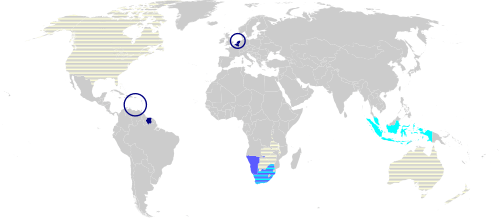 |
| Bengali | 243 M | 262 M[50] | Official language in: India (in West Bengal, Tripura and Assam) and Bangladesh | 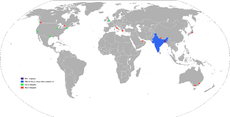 |
| Malay and Indonesian | 39 M | 218 M[51][52] | List of territorial entities where Malay is an official language | 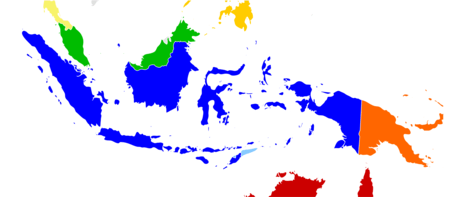 |
| Swahili | 16 M | 98 M[53] [54] [55] | Official language in:Tanzania, Kenya, Democratic Republic of the Congo, Rwanda, Uganda, African Union and East African Community | 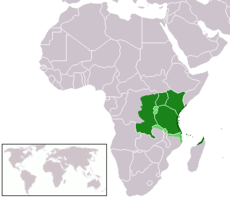 |
| Persian | 58[56] to 60 M[57] | 61 M[56][58] to 110 M[57] | Official language in: Iran, Afghanistan (as Dari) and Tajikistan (as Tajik) |  |
| Turkish | 74 M | 79 M[59] to 100 M[60] [61] | Official language in: Turkey, Cyprus, Northern Cyprus Recognized minority language in: Bosnia and Herzegovina, Macedonia, Romania, Iraq, Greece, Republic of Kosovo | 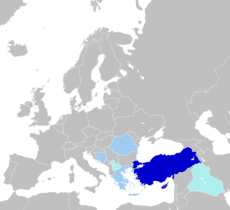 |
| Italian | 65 M | 68 M[62] to 85 M[63] | Official language in: Italy, Switzerland, San Marino, Sovereign Military Order of Malta, Vatican City. Italian is relevant in countries affected by the Italian diaspora and in former colonies and occupied territories of the Italian Empire. | 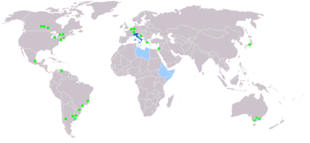 |
| Tamil | 68 M | 75 M[64] | List of territorial entities where Tamil is an official language |  |
See also
Notes
- In contrast to other pluricentric languages (e.g., Arabic or Malay), Ethnologue only lists "Standard German", thereby excluding Swiss German and numerous other varieties of German.[45] Summing up Standard German as well as all undisputed German dialects/varieties (see ISO-list in infobox at German language) that are not listed under "Standard German" results in ca. 90 M native speakers. Furthermore, Ammon (2014)[46] points out that Ethnologue overestimates L2 speakers, thus underestimating L1 speakers, in Germany by 5M --> 95M L1 speakers.
References
- Fischer Weltalmanach. S. Fischer Verlag. Archived from the original on September 4, 2009.
- Baker, Colin; Jones, Sylvia Prys (1998). Encyclopedia of Bilingualism and Bilingual Education. Multilingual Matters. ISBN 9781853593628 https://books.google.com/books?id=YgtSqB9oqDIC. Missing or empty
|title=(help) - "English". Ethnologue.
- "Constitution of the Republic of South Africa, 1996 - Chapter 1: Founding Provisions | South African Government". www.gov.za.
- "A Brief History of the Tamils of Mauritius (M. Sangeelee)". tamilelibrary.org.
- "National Identity and Minority Languages | UN Chronicle". unchronicle.un.org.
- Heritage, Canadian (January 3, 2019). "Statement by Minister Rodriguez on Tamil Heritage Month". gcnws.
- "Summary by country". Ethnologue. Retrieved 2018-09-22.
- Languages Spoken by More Than 10 Million People. Microsoft Encarta 2006. Archived from the original on January 9, 2006. Retrieved 2007-02-18.
- Wei, Rining; Jinzhi Su (2012). "The statistics of English in China". English Today. 28 (3): 10–14. doi:10.1017/s0266078412000235.
- Crystal, David (2006). "9 - English worldwide". In Hogg, Richard; Denison, David (eds.). A History of the English Language. Cambridge University Press. pp. 420–439.
- Héran, François (June 2013). "No English please! Survey on the languages used for research and teaching in France" (PDF). Population & Sociétés (501).
- "Usage Statistics of Content Languages for Websites". W3Techs. Retrieved July 14, 2019.
- "Number of Internet Users by Language". Internet World Stats. Retrieved 2019-07-14.
- "Official Languages". United Nations. Retrieved 2016-10-29.
- "European Commission - PRESS RELEASES - Press release - Frequently asked questions on languages in Europe". europa.eu. Retrieved 2017-03-11.
- "Russian: Eurasia's Most Geographically Widespread Language". Day Translations Blog. 4 August 2014.
- Blank, Stephen (9 January 2015). "Russia's Waning Soft Power in Central Asia". The Diplomat.
- "Kyrgyzstan's Russian-Language Teaching Getting Squeezed Out". Eurasianet. 15 December 2014.
- Brooke, James (17 October 2012). "English Replaces Russian as Top Foreign Language of Study in Ex-Soviet Georgia". VOA News.
- Language Use in the United States: 2011 (Table 3, p.9). Census.gov.
- Goldberg, David; Looney, Dennis; Lusin, Natalia (February 2019), Enrollments in Languages Other Than English in United States Institutions of Higher Education, Summer 2016 and Fall 2016: Preliminary Report (PDF), Modern Language Association of America, retrieved March 4, 2019
- Nasr, Seyyed Hossein (2003). Islam: Religion, History, and Civilization. HarperCollins.
- Pei, p. 105
- "What Is a World Language? (with pictures)". wisegeek.com.
- Wallraff, Barbara. "What Global Language?".
- "These are the most powerful languages in the world". World Economic Forum.
- cf. Pei p. 15
- Ammon, Ulrich (1989). Status and Function of Languages and Language Varieties. W. de Gruyter. ISBN 9780899253565.
- Mazrui, Ali AlʼAmin (1976). A World Federation of Cultures: An African Perspective. Free Press.
- "Summary by language size". Ethnologue. Retrieved 2019-03-01.
- English at Ethnologue (22nd ed., 2019)
- French at Ethnologue (22nd ed., 2019)
- "Summary by language size". Ethnologue. Retrieved 2019-03-01.
- Spanish at Ethnologue (22nd ed., 2019)
- Chinese at Ethnologue (22nd ed., 2019)
- Arabic at Ethnologue (22nd ed., 2019)
- Portuguese at Ethnologue (22nd ed., 2019)
- Government of India, Ministry of Home Affairs. "C-17 POPULATION BY BILINGUALISM AND TRILINGUALISM". Archived from the original on 2019-11-13. Retrieved 2019-10-16.
- "Indiaspeak: English is our 2nd language – Times of India".
- Urdu at Ethnologue (22nd ed., 2019)
- https://blog.busuu.com/most-spoken-languages-in-the-world/
- Russian at Ethnologue (22nd ed., 2019)
- https://blog.lingoda.com/en/most-spoken-languages-in-the-world-in-2020
- German, Standard at Ethnologue (22nd ed., 2019)
- Ammon, Ulrich - Die Stellung der deutschen Sprache in der Welt (de Gruyter Mouton; ISBN 978-3-11-019298-8)
- "Summary by language size".
- "Dutch". Ethnologue.
- "Afrikaans". Ethnologue.
- "Bengali".
- "Malay".
- "Indonesian".
- "Swahili". Ethnologue.
- Irele, F. Abiola; Jeyifo, Biodun, eds. (2010). The Oxford Encyclopedia of African Thought. 1. Oxford University Press. p. 362. ISBN 978-0-19-533473-9.
- "Swahili". Stanford Language Center."Swahili". Stanford Language Center.
- "Persian, Iranian". Ethnologue.
- Windfuhr, Gernot, ed. (2009). The Iranian Languages. London: Routledge. pp. 418.
- "Dari". Ethnologue.
- "Turkish". Ethnologue.
- Katzner
- Europeans and their Languages (PDF), Special Eurobarometer 243, European Commission, February 2006
- "Italian". Ethnologue.
- "Italian". University of Leicester. Retrieved 2018-09-21.
- "Tamil". Ethnologue.
Bibliography
- Christian Mair (ed.), The Politics of English As a World Language (2003), ISBN 978-90-420-0876-2.
- Mario Pei, One Language for the World (1958), ISBN 978-0-8196-0218-3.
- Anne-Marie De Mejía, Power, Prestige, and Bilingualism: International Perspectives on Elite Bilingual Education (2002), ISBN 978-1-85359-590-5.
- David Crystal, English as a Global Language (2003), ISBN 978-0-521-53032-3.
- Clare Mar-Molinero, The Politics of Language in the Spanish-speaking World (2000), ISBN 978-0-415-15655-4.
- George Weber, The World's 10 most influential Languages
